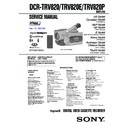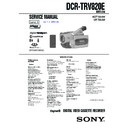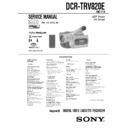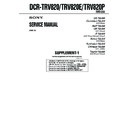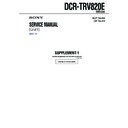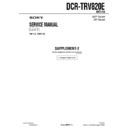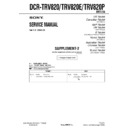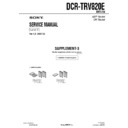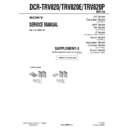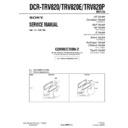Read Sony DCR-TRV820 / DCR-TRV820E / DCR-TRV820P Service Manual online
SERVICE MANUAL
DIGITAL VIDEO CASSETTE RECORDER
SPECIFICATIONS
RMT-814
B700 MECHANISM
TM
– Continued on next page –
NTSC MODEL : DCR-TRV820/TRV820P
PAL MODEL
PAL MODEL
: DCR-TRV820E
For MECHANISM ADJUSTMENT, refer to
the “8mm Video MECHANICAL
ADJUSTMENT MANUAL ” (9-973-801-11).
the “8mm Video MECHANICAL
ADJUSTMENT MANUAL ” (9-973-801-11).
Photo: DCR-TRV820E
US Model
Canadian Model
DCR-TRV820
AEP Model
UK Model
DCR-TRV820E
E Model
DCR-TRV820/TRV820E/TRV820P
Korea Model
DCR-TRV820
Australian Model
Chinese Model
DCR-TRV820E
Tourist Model
DCR-TRV820/TRV820E
DCR-TRV820/TRV820E/TRV820P
Video camera
recorder
recorder
System
Video recording system
2 rotary heads
Helical scaning system
Helical scaning system
Audio recording system
Rotary heads, PCM system
Quantization: 12 bits (Fs 32 kHz,
stereo 1, stereo 2), 16 bits
(Fs 48 kHz, stereo)
Quantization: 12 bits (Fs 32 kHz,
stereo 1, stereo 2), 16 bits
(Fs 48 kHz, stereo)
Video signal
DCR-TRV820/TRV820P :
NTSC color, EIA standards
DCR-TRV820E :
PAL colour, CCIR standards
NTSC color, EIA standards
DCR-TRV820E :
PAL colour, CCIR standards
Recommended cassette
Hi8/Digital8 video cassette
Recording/Playback time (using
120 min. Hi8 video cassette)
120 min. Hi8 video cassette)
SP mode: 1 hour
LP mode: 1 hour and 30 minutes
LP mode: 1 hour and 30 minutes
Fastforward/rewind time (using
120 min. Hi8 video cassette)
120 min. Hi8 video cassette)
Approx. 5 min.
Viewfinder
Electric Viewfinder (colour)
Image device
1/4 type CCD (Change Coupled
Device)
DCR-TRV820/TRV820P :
Approx. 460,000 pixels
(Effective: Approx. 290,000 pixels)
DCR-TRV820E :
Approx. 800,000 pixels
(Effective: Approx. 400,000 pixels)
Device)
DCR-TRV820/TRV820P :
Approx. 460,000 pixels
(Effective: Approx. 290,000 pixels)
DCR-TRV820E :
Approx. 800,000 pixels
(Effective: Approx. 400,000 pixels)
Lens
Combined power zoom lens
Filter diameter 37 mm (1 1/2 in.)
25
Filter diameter 37 mm (1 1/2 in.)
25
×
(Optical)
DCR-TRV820/TRV820E: E, AUS, CN,
JE/TRV820P :
450
JE/TRV820P :
450
×
(Digital)
DCR-TRV820E: AEP, UK :
100
100
×
(Digital)
Focal length
3.7 - 92.5 mm (5/32 - 3 3/4 in.)
When converted to a 35 mm still camera
48 - 1200 mm (1 15/16 - 47 1/4 in.)
When converted to a 35 mm still camera
48 - 1200 mm (1 15/16 - 47 1/4 in.)
Colour temperature
Auto
Minimum illumination
DCR-TRV820/TRV820P :
1 lux (F 1.6)
DCR-TRV820E :
3 lux (F 1.6)
0 lux (in the NightShot mode)*
* Objects unable to be seen due to the
1 lux (F 1.6)
DCR-TRV820E :
3 lux (F 1.6)
0 lux (in the NightShot mode)*
* Objects unable to be seen due to the
dark can be shot with infrared
lighting.
lighting.
Input/output
connectors
connectors
DCR-TRV820/TRV820P :
S video input/output
4-pin mini DIN
Luminance signal: 1 Vp-p,
75 ohms, unbalanced
Chrominance signal: 0.286 Vp-p,
75 ohms, unbalanced
Luminance signal: 1 Vp-p,
75 ohms, unbalanced
Chrominance signal: 0.286 Vp-p,
75 ohms, unbalanced
Audio/Video input/output
AV MINIJACK, 1 Vp-p, 75 ohms,
unbalanced, sync negative
327 mV, (at output impedance more than
47 kilohms)
Output impedance with less than 2.2
kilohms/Stereo minijack (ø 3.5 mm)
Input impedance more than 47 kilohms
DCR-TRV820E :
unbalanced, sync negative
327 mV, (at output impedance more than
47 kilohms)
Output impedance with less than 2.2
kilohms/Stereo minijack (ø 3.5 mm)
Input impedance more than 47 kilohms
DCR-TRV820E :
S video input/output
4-pin mini DIN
Luminance signal: 1 Vp-p,
75 ohms, unbalanced
Chrominance signal: 0.3 Vp-p,
75 ohms, unbalanced
Luminance signal: 1 Vp-p,
75 ohms, unbalanced
Chrominance signal: 0.3 Vp-p,
75 ohms, unbalanced
Audio/Video output
AV MINIJACK, 1 Vp-p, 75 ohms,
unbalanced, sync negative
327 mV, (at output impedance more than
47 kilohms)
Output impedance with less than 2.2
kilohms/Stereo minijack (ø 3.5 mm)
unbalanced, sync negative
327 mV, (at output impedance more than
47 kilohms)
Output impedance with less than 2.2
kilohms/Stereo minijack (ø 3.5 mm)
DV input/output
4-pin connector
Headphone jack
Stereo minijack (ø 3.5 mm)
LANC
/DIGITAL I/O jack
Stereo mini-minijack (ø 2.5 mm)
Transfer rate: Max 115.2 Kbps
RS-232C based
Transfer rate: Max 115.2 Kbps
RS-232C based
MIC jack
Stereo minijack (ø 3.5 mm)
When the machine needs to be repaired,
please refer to page 8 to discriminate the
type of LCD.
please refer to page 8 to discriminate the
type of LCD.
Ver. 1.5 2007.05
– 2 –
1. Check the area of your repair for unsoldered or poorly-sol-
dered connections. Check the entire board surface for solder
splashes and bridges.
splashes and bridges.
2. Check the interboard wiring to ensure that no wires are
“pinched” or contact high-wattage resistors.
3. Look for unauthorized replacement parts, particularly transis-
tors, that were installed during a previous repair. Point them
out to the customer and recommend their replacement.
out to the customer and recommend their replacement.
4. Look for parts which, though functioning, show obvious signs
of deterioration. Point them out to the customer and recom-
mend their replacement.
mend their replacement.
SAFETY CHECK-OUT
After correcting the original service problem, perform the following
safety checks before releasing the set to the customer.
safety checks before releasing the set to the customer.
5. Check the B+ voltage to see it is at the values specified.
6. Flexible Circuit Board Repairing
•
Keep the temperature of the soldering iron around 270 ˚C
during repairing.
during repairing.
•
Do not touch the soldering iron on the same conductor of
the circuit board (within 3 times).
the circuit board (within 3 times).
•
Be careful not to apply force on the conductor when sol-
dering or unsoldering.
dering or unsoldering.
ATTENTION AU COMPOSANT AYANT RAPPORT
À LA SÉCURITÉ!
LES COMPOSANTS IDENTIFIÉS PAR UNE MARQUE
0
SUR LES DIAGRAMMES SCHÉMATIQUES ET LA LISTE
DES PIÈCES SONT CRITIQUES POUR LA SÉCURITÉ
DE FONCTIONNEMENT. NE REMPLACER CES COM-
POSANTS QUE PAR DES PIÈCES SONY DONT LES
NUMÉROS SONT DONNÉS DANS CE MANUEL OU
DANS LES SUPPLÉMENTS PUBLIÉS PAR SONY.
DES PIÈCES SONT CRITIQUES POUR LA SÉCURITÉ
DE FONCTIONNEMENT. NE REMPLACER CES COM-
POSANTS QUE PAR DES PIÈCES SONY DONT LES
NUMÉROS SONT DONNÉS DANS CE MANUEL OU
DANS LES SUPPLÉMENTS PUBLIÉS PAR SONY.
SAFETY-RELATED COMPONENT WARNING!!
COMPONENTS IDENTIFIED BY MARK
0
OR DOTTED
LINE WITH MARK
0
ON THE SCHEMATIC DIAGRAMS
AND IN THE PARTS LIST ARE CRITICAL TO SAFE
OPERATION. REPLACE THESE COMPONENTS WITH
SONY PARTS WHOSE PART NUMBERS APPEAR AS
SHOWN IN THIS MANUAL OR IN SUPPLEMENTS PUB-
LISHED BY SONY.
OPERATION. REPLACE THESE COMPONENTS WITH
SONY PARTS WHOSE PART NUMBERS APPEAR AS
SHOWN IN THIS MANUAL OR IN SUPPLEMENTS PUB-
LISHED BY SONY.
LCD screen
Picture
4.0 type
80.6
80.6
×
60.5 mm (3 1/4
×
2 1/2 in.)
Total dot number
123,200 (560
×
220)
Printer
Print method
Variable dot thermal transfer
Print resolution
254 dpi
Number of printed dots
640
×
480 (paper feed direction)
Print speed
2.54 mm (1/8 in.)/second
Size of print paper
91
×
55 mm
(3 5/8
×
2 1/4 in.)
Print area size
64
×
48 mm
(2 5/8
×
1 15/16 in.)
Number of prints per print
cartridge roll
cartridge roll
20
Power Consumption
8 W
General
power requirements
7.2 V (battery pack)
8.4 V (AC power adaptor)
8.4 V (AC power adaptor)
Average power consumption
(When using the battery pack)
(When using the battery pack)
During camera recording using
LCD
4.4 W
Viewfinder
DCR-TRV820/TRV820P :
3.0 W
DCR-TRV820E :
3.1 W
LCD
4.4 W
Viewfinder
DCR-TRV820/TRV820P :
3.0 W
DCR-TRV820E :
3.1 W
Operating temperature
0 °C to 40 °C (32 °F to 104 °F)
Storage temperature
–20 °C to +60 °C (–4 °F to +140 °F)
Dimensions (approx.)
112
×
121
×
218 mm
(4 1/2
×
4 7/8
×
8 5/8 in.) (w/h/d)
Mass (approx.)
1.3 kg (2 lb 13 oz)
excluding the battery pack, lithium
battery, cassette and shoulder strap
1.4 kg (3 lb 1 oz)
DCR-TRV820/TRV820P :
including the battery pack NP-F330,
lithium battery CR2025, 120 min. Hi8
cassette, and shoulder strap
DCR-TRV820E :
including the battery pack NP-F330,
lithium battery CR2025, 90 min. Hi8
cassette, and shoulder strap
excluding the battery pack, lithium
battery, cassette and shoulder strap
1.4 kg (3 lb 1 oz)
DCR-TRV820/TRV820P :
including the battery pack NP-F330,
lithium battery CR2025, 120 min. Hi8
cassette, and shoulder strap
DCR-TRV820E :
including the battery pack NP-F330,
lithium battery CR2025, 90 min. Hi8
cassette, and shoulder strap
AC power adaptor
Power requirements
100 - 240 V AC, 50/60 Hz
Power consumption
23 W
Output voltage
DC OUT: 8.4 V, 1.5 A in the
operating mode
operating mode
Operating temperature
0 °C to 40 °C (32 °F to 104 °F)
Storage temperature
–20 °C to +60 °C (–4 °F to +140 °F)
Dimensions (approx.)
125
×
39
×
62 mm
(5
×
1 9/16
×
2 1/2 in.) (w/h/d)
excluding projecting parts
Mass (approx.)
280 g (9.8 oz)
excluding power cord
excluding power cord
Battery Pack
Output voltage
DC 7.2 V
Capacity
5.0 Wh
Dimensions (approx.)
38
×
21
×
71 mm
(1 9 /16
×
1 3/16
×
2 7/8 in.) (w/h/d)
Mass (approx.)
95 g (3.4 oz)
Type
Lithium ion
“Memory Stick”
Memory
Flash memory
4 MB: MSA-4A
4 MB: MSA-4A
Operating voltage
2.7 - 3.6 V
Power consumption
Approx. 45 mA in the operating mode
Approx. 130 µA in the standby mode
Approx. 130 µA in the standby mode
Dimensions (approx.)
50
×
2.8
×
21.5 mm
(2
×
1/8
×
7/8 in.) (w/h/d)
Mass (approx.)
4 g (0.14 oz)
Design and specifications are subject to
change without notice.
change without notice.
– 3 –
Table for differences of function
AEP, UK
PAL
100
×
960H
CD-271
Model
Destination
Color system
Digital zoom
CCD imager
LCD type
CD board
DCR-TRV820
US, CND, E,
KR, JE
E, AUS,
CN, JE
PAL
450
×
960H
CD-271
DCR-TRV820E
• Abbreviation
AUS : Australian model
CN
CN
: Chinese model
CND : Canadian model
JE
JE
: Tourist model
KR
: Korea model
DCR-TRV820P
E
NTSC
450
×
720H
CD-270
Supplied accessories
1
Wireless Remote Commander
(1)
2
AC-L10A/L10B/L10C AC Power adaptor
(1),
Mains lead
(1)
3
NP-F330 battery pack
(1)
4
CR2025 lithium battery
(1)
The lithium battery is already installed in your camcorder.
5
R6 (Size AA) battery for Remote Commander
(2)
6
A/V connecting cable
(1)
7
Shoulder strap
(1)
8
Lens cap
(1)
9
21-pin adaptor
(1)
DCR-TRV820E: AEP, UK
0
2-pin conversion adaptor
(1)
DCR-TRV820: E/TRV820E: E/TRV820P
qa
2-pin conversion adaptor
(1)
DCR-TRV820: JE/TRV820E: JE
qs
Carrying bag
(1)
DCR-TRV820P
qd
PC serial cable
(1)
qf
“Memory Stick”
(1)
qg
Application software: PictureGear 4.1 Lite (CD ROM)
(1)
qh
Print paper
Standard type
Standard type
(20 sheets
×
1),
Sticker type/Standard size
(10 sheets
×
1),
Sticker type/9 split size
(10 sheets
×
1)
qj
Print cartridge
(2)
qh
qj
Please refer to page 8 to discriminate the type of LCD (TYPE C or TYPE S).
– 4 –
TABLE OF CONTENTS
Section
Title
Page
Section
Title
Page
SERVICE NOTE
1.
Power Supply During Repairs .................................... 7
2.
To Take Out a Cassette
When Not Eject (Force Eject) .................................... 7
When Not Eject (Force Eject) .................................... 7
3.
Note for Repair ........................................................... 8
4.
LCD Type Check ........................................................ 8
SELF-DIAGNOSIS FUNCTION
1.
Self-diagnosis Function .............................................. 9
2.
Self-diagnosis Display ................................................ 9
3.
Service Mode Display ................................................ 9
3-1.
Display Method ........................................................... 9
3-2.
Switching of Backup No. ............................................ 9
3-3.
End of Display ............................................................ 9
4.
Self-diagnosis Code Table ......................................... 10
1.
GENERAL
Checking Supplied Accessories .......................................... 1-1
Quick Start Guide ................................................................. 1-1
Using This Manual ................................................................ 1-2
Step 1 Preparing the Power Supply ..................................... 1-2
Step 2 Inserting a Cassette .................................................. 1-4
Recording a Picture .............................................................. 1-5
Checking the Recording
– END SEARCH/EDIT SEARCH/Rec Review ..................... 1-7
Playing Back a Tape ............................................................. 1-8
Viewing the Recording on TV ............................................... 1-9
Recording a Still Image on a Tape
– Tape Photo Recording ....................................................... 1-10
Using the Wide Mode ........................................................... 1-11
Using the Fader Function ..................................................... 1-11
Using Special Effects
– Picture Effect ..................................................................... 1-12
Using Special Effects
– Digital Effect ...................................................................... 1-12
Using the PROGRAM AE Function ...................................... 1-13
Adjusting the Exposure Manually ......................................... 1-13
Focusing Manually ............................................................... 1-14
Superimposing a Title ........................................................... 1-14
Making Your Own Titles ........................................................ 1-15
Inserting a Scene ................................................................. 1-15
Playing Back a Tape with Picture Effects ............................. 1-15
Playing Back a Tape with Digital Effects .............................. 1-16
Enlarging Recorded Images
– PB ZOOM .......................................................................... 1-16
Quickly Locating a Scene Using the Zero Set
Memory Function .................................................................. 1-16
Searching a Recording by Date
– Date Search ....................................................................... 1-17
Searching for a Photo
– Photo Search/Photo Scan ................................................. 1-17
Dubbing a Tape .................................................................... 1-18
Using with Analog Video Unit and PC
– Signal Convert Function .................................................... 1-19
Recording Video or TV Programmes ................................... 1-19
Inserting a Scene from a VCR
– Insert Editing ...................................................................... 1-20
Changing the Menu Settings ................................................ 1-21
Resetting the Date and Time ................................................ 1-23
Using “Memory Stick” – Introduction .................................... 1-23
Recording Still Images on “Memory Stick”
– Memory Photo Recording ................................................. 1-24
Superimposing a Still Image in the
“Memory Stick” on a moving Image
– MEMORY MIX ................................................................... 1-26
Recording an Image from a Tape as a Still Image .............. 1-27
Copying Still Images from a Tape
– Photo Save ........................................................................ 1-27
Quick Start Guide ................................................................. 1-1
Using This Manual ................................................................ 1-2
Step 1 Preparing the Power Supply ..................................... 1-2
Step 2 Inserting a Cassette .................................................. 1-4
Recording a Picture .............................................................. 1-5
Checking the Recording
– END SEARCH/EDIT SEARCH/Rec Review ..................... 1-7
Playing Back a Tape ............................................................. 1-8
Viewing the Recording on TV ............................................... 1-9
Recording a Still Image on a Tape
– Tape Photo Recording ....................................................... 1-10
Using the Wide Mode ........................................................... 1-11
Using the Fader Function ..................................................... 1-11
Using Special Effects
– Picture Effect ..................................................................... 1-12
Using Special Effects
– Digital Effect ...................................................................... 1-12
Using the PROGRAM AE Function ...................................... 1-13
Adjusting the Exposure Manually ......................................... 1-13
Focusing Manually ............................................................... 1-14
Superimposing a Title ........................................................... 1-14
Making Your Own Titles ........................................................ 1-15
Inserting a Scene ................................................................. 1-15
Playing Back a Tape with Picture Effects ............................. 1-15
Playing Back a Tape with Digital Effects .............................. 1-16
Enlarging Recorded Images
– PB ZOOM .......................................................................... 1-16
Quickly Locating a Scene Using the Zero Set
Memory Function .................................................................. 1-16
Searching a Recording by Date
– Date Search ....................................................................... 1-17
Searching for a Photo
– Photo Search/Photo Scan ................................................. 1-17
Dubbing a Tape .................................................................... 1-18
Using with Analog Video Unit and PC
– Signal Convert Function .................................................... 1-19
Recording Video or TV Programmes ................................... 1-19
Inserting a Scene from a VCR
– Insert Editing ...................................................................... 1-20
Changing the Menu Settings ................................................ 1-21
Resetting the Date and Time ................................................ 1-23
Using “Memory Stick” – Introduction .................................... 1-23
Recording Still Images on “Memory Stick”
– Memory Photo Recording ................................................. 1-24
Superimposing a Still Image in the
“Memory Stick” on a moving Image
– MEMORY MIX ................................................................... 1-26
Recording an Image from a Tape as a Still Image .............. 1-27
Copying Still Images from a Tape
– Photo Save ........................................................................ 1-27
Viewing a Still Image
– Memory Photo Playback ................................................... 1-28
Copying the Image Recorded on
“Memory Stick” to Tapes ....................................................... 1-29
Enlarging Still Images Recorded on “Memory Stick”s
– Memory PB ZOOM ............................................................ 1-29
Playing Back Images in a Continuous Loop
– SLIDE SHOW .................................................................... 1-30
Preventing Accidental Erasure
– Image Protection ............................................................... 1-30
Deleting Images .................................................................... 1-31
Writing a Print Mark
– PRINT MARK ..................................................................... 1-31
Using the Printer
– Introduction ........................................................................ 1-32
Making Prints
– Standard Print .................................................................... 1-34
Making Prints of Split Screens
– Sprit Printing ...................................................................... 1-36
Digital8 System, Recording and Playback ........................... 1-36
About i. LINK ........................................................................ 1-37
Changing the Lithium Battery in Your Camcorder ............... 1-37
Troubleshooting .................................................................... 1-38
Self-diagnosis Display .......................................................... 1-39
Warning Indicators and Messages ....................................... 1-39
Using Your Camcorder Abroad ............................................ 1-40
Maintenance Information and Precautions .......................... 1-40
Identifying the Parts and Controls ........................................ 1-41
– Memory Photo Playback ................................................... 1-28
Copying the Image Recorded on
“Memory Stick” to Tapes ....................................................... 1-29
Enlarging Still Images Recorded on “Memory Stick”s
– Memory PB ZOOM ............................................................ 1-29
Playing Back Images in a Continuous Loop
– SLIDE SHOW .................................................................... 1-30
Preventing Accidental Erasure
– Image Protection ............................................................... 1-30
Deleting Images .................................................................... 1-31
Writing a Print Mark
– PRINT MARK ..................................................................... 1-31
Using the Printer
– Introduction ........................................................................ 1-32
Making Prints
– Standard Print .................................................................... 1-34
Making Prints of Split Screens
– Sprit Printing ...................................................................... 1-36
Digital8 System, Recording and Playback ........................... 1-36
About i. LINK ........................................................................ 1-37
Changing the Lithium Battery in Your Camcorder ............... 1-37
Troubleshooting .................................................................... 1-38
Self-diagnosis Display .......................................................... 1-39
Warning Indicators and Messages ....................................... 1-39
Using Your Camcorder Abroad ............................................ 1-40
Maintenance Information and Precautions .......................... 1-40
Identifying the Parts and Controls ........................................ 1-41
2.
DISASSEMBLY
2-1.
LCD Assembly, PD-118 Board ................................... 2-2
2-2.
VF-141 Board, VF Lens Assembly ............................. 2-3
2-3.
Front Panel Assembly ................................................ 2-4
2-4.
Cassette Lid Assembly, Cabinet (L) Assembly .......... 2-4
2-5.
Cabinet (R) Assembly ................................................ 2-5
2-6.
PC-78 Board ............................................................... 2-5
2-7.
Cabinet (L) Assembly ................................................. 2-6
2-8.
Battery Panel Assembly ............................................. 2-6
2-9.
PR-33 Board, Printer Unit .......................................... 2-6
2-10. CF-72 Board ............................................................... 2-7
2-11. Lens Block .................................................................. 2-8
2-12. SE-114 Board, Control Switch Block (FK-10000) ...... 2-8
2-13. FU-141 Board ............................................................. 2-8
2-14. VC-235 Board ............................................................. 2-8
2-15. Circuit Boards Location .............................................. 2-10
2-16. Flexible Boards Location ............................................ 2-11
2-11. Lens Block .................................................................. 2-8
2-12. SE-114 Board, Control Switch Block (FK-10000) ...... 2-8
2-13. FU-141 Board ............................................................. 2-8
2-14. VC-235 Board ............................................................. 2-8
2-15. Circuit Boards Location .............................................. 2-10
2-16. Flexible Boards Location ............................................ 2-11
3.
BLOCK DIAGRAMS
3-1.
Overall Block Diagram 1 ............................................ 3-1
3-2.
Overall Block Diagram 2 ............................................ 3-3
3-3.
Overall Block Diagram 3 ............................................ 3-5
3-4.
Overall Block Diagram 4 ............................................ 3-7
3-5.
Power Block Diagram 1 .............................................. 3-9
3-6.
Power Block Diagram 2 .............................................. 3-11
3-7.
Power Block Diagram 3 .............................................. 3-13
4.
PRINTED WIRING BOARDS AND
SCHEMATIC DIAGRAMS
SCHEMATIC DIAGRAMS
4-1.
Frame Schematic Diagrams ...................................... 4-3
Frame (1) Schematic Diagram ................................... 4-3
Frame (2) Schematic Diagram ................................... 4-5
Frame (1) Schematic Diagram ................................... 4-3
Frame (2) Schematic Diagram ................................... 4-5
4-2.
Printed Wiring Boards and Schematic Diagrams ...... 4-7
CD-270 Printed Wiring Board and
Schematic Diagram .................................................... 4-7
CD-271 Printed Wiring Board and
Schematic Diagram .................................................... 4-9
VC-235 Printed Wiring Board .................................... 4-11
CD-270 Printed Wiring Board and
Schematic Diagram .................................................... 4-7
CD-271 Printed Wiring Board and
Schematic Diagram .................................................... 4-9
VC-235 Printed Wiring Board .................................... 4-11

